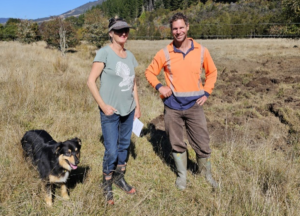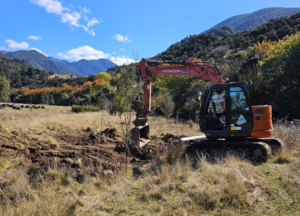Ka ora te whenua, ka ora te tangata – caring for the whenua is the first priority
Monday 8 April was the day work started on the first wetland supported by the Motueka Catchment Collective, and I was off up the Baton Valley to capture a slice of the action.

After driving 15 km up a gravel road that wove alongside the Baton River, I walked across a private swingbridge, feeling like I was crossing over a threshold into a magical, secret pocket of the world.
The path opened to an expansive view towards the mountains and the deep wilderness of the Kahurangi National Park, and a grand two storey house on an elevated platform looking down on the valley, the Baton House – a replica of the Baton Hotel, constructed in 1860’s during the gold mining boom.
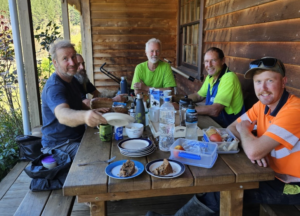
Walking up to the house I could hear happy chatter and see a number of people sitting at the table and on the deck. As it turned out, they were workers having smoko after starting construction on two replica miners’ cottages for guest accommodation. Also present were neighbours, Dion McLean and Fiona Simons. Dion is the 5th generation of his family in the valley! I could really feel the sense of history and wairua of this special place.
Ange Palmer, the caretaker of the land for the past three years, welcomed me. Ange has been part of the Baton Valley community for 20 years and is deeply invested in enacting the vision of the owners, Lucy Ulrich and Marten Leek, and the local community, to care for the whenua and respect its history. Ange is a medical herbalist, and until covid came along, ran a health and wellness centre in Nelson.
Ange acknowledged the significance of the day – with the commencement of construction of the wetland and the cottages. She talked about the values of the Baton Valley Trust being to care for Earth Mother and to look after the smallest organisms. She summoned memories of the ancestors of the whenua, and the atua of the land – Papatūānuku and Ranginui. We then ate celebration cake!
After lunch, Ange, dog Tusca and Craig Allen of Freshwater Environmental, who’s managing the wetland build headed off down the hill to check out progress. The digger was very busy at work.
Craig explained that the goal with this project is to enhance and extend the existing groundwater-fed wetland areas by raising the groundwater level.
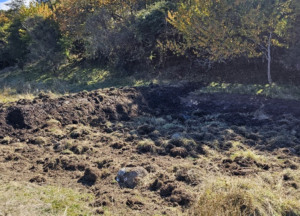
The plan is to create a number of bunds – areas of raised ground, across low lying drainage pathways to create shallow pools less than 500mm deep. This raises the groundwater level to within 300mm of the ground surface of approximately 1 hectare of the surrounding land. Each bund has a spillway that allows water to travel over it to the next pool. Around 6-7 bunds were being constructed up the narrow stream bed. Usually the land here is very wet and boggy but the unusually dry summer means there’s no water at present.
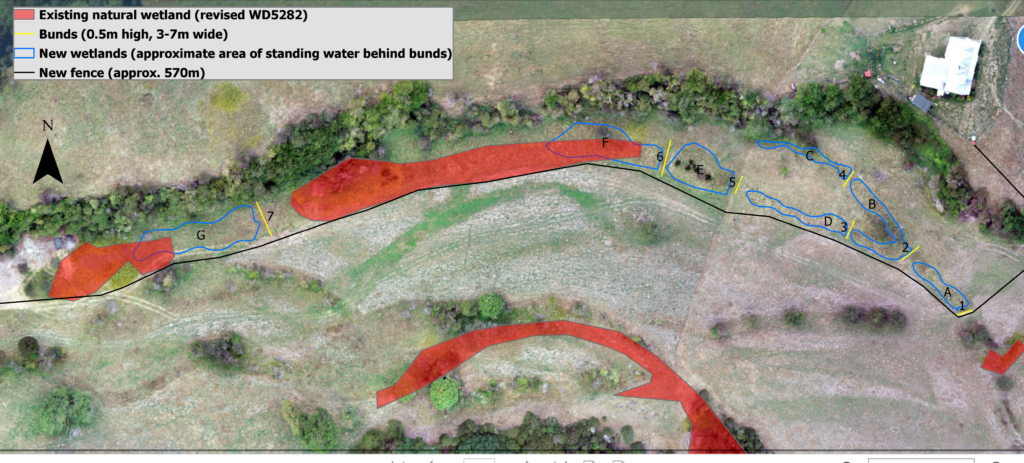

Undertaking this work will favour native wetland and riparian plant species over pasture grass and weeds such as hawthorn, blackberry and cherry. The hope is that these weeds will either die off or be outcompeted by the natives. In areas where there is a pre-existing native seed stock within the soils, such as low-lying areas once occupied by wetland, the plants will spread naturally providing they are not grazed or trodden on by stock.
Craig and Ange discussed what should be done about fencing. A question was whether to exclude just the cattle with a hot wire or do full proper fence to keep sheep out too. Craig suggested the approach of fully fencing part of the wetland and do a hot wire on the upper part of the wetland. There’s then the opportunity to compare between fully fenced and other area to see which is regenerating better.
Craig says:
“in terms of biodiversity benefits, this wetland area is less about the fish, and more about the plants. There are kanuka and manuka islands that can have antibacterial properties that treat the water through the soil, important for a working farm. There should be some reeds and grasses which will attenuate the nitrogen.
“it’s great if a landowner can treat the impact of their landuse. In the ideal world every farmer would have a treatment wetland at the corner of their property – this stops the sediment, nutrients, e coli going into the river”.
This wetland project is not the only idea Ange wants to see put into fruition. There are many other ideas to progress, some of which were identified at a ‘ground truthing’ event with 12 key community members held at Baton House in 2022. Going forward the Trust hopes to create a tōtara plantation of 30,000 trees, a circular production forest – Ange is getting onto this project too. Although it is hard work and there’s much to do Ange says:
“There’s not a day that I don’t step outside and think how lucky I am – I’m living my dream”.
I feel privileged to have had the opportunity to visit the Baton House and meet Ange and some of the Baton Valley community; to see this work in progress, and to learn a bit about a slice of history of this place, a very special part of the Motueka catchment.
Here’s Ange Palmer talking about the context and goals for the wetland project happening currently on a beautiful piece of whenua up the Baton Valley.
Dana Carter, Motueka Catchment Collective


